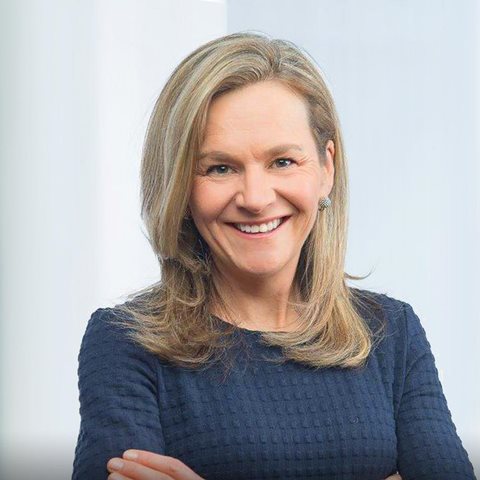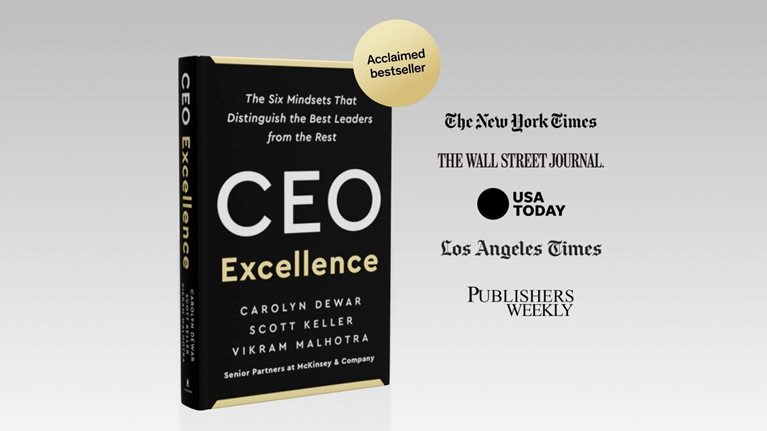What makes an effective CEO? In short, comfort with embracing polarities.
CEOs sit at the nexus of organizational tensions, balancing seemingly opposing demands. They must be confident and humble, decisive and empowering, professional and authentic. They must also deliver short-term results and offer a longer-term vision.
In today’s disruptive world, leadership is not only about the business-related tasks that get results. CEOs also need to develop and exhibit personal attributes that make a lasting impact with teams and the broader organization. These human-centric attributes include being self-aware, humble, and resilient. Leaders with these qualities are good at synthesizing multiple perspectives rather than being stymied by polarities. They move away from an “either/or” mindset to one that is comfortable with “both/and.”
Research on leadership1 indicates that women tend to score high on relational competencies, systems thinking, learning mindsets, and purpose-driven vision—exactly the kind of human-centric attributes CEOs need to navigate today’s complexities. Yet they are much less likely to get the top job; just 52 of Fortune 500 companies2 have a woman at the helm. Women also tend to be underrepresented in positions with profit-and-loss responsibility and as chief financial officers, which can be the last C-suite stop before CEO.
Still, many women have cleared these hurdles without losing the authenticity of their leadership style. We interviewed early-tenure women CEOs3 to understand the mindsets, values, and philosophies that have guided them—what we call their inner game. We delved into how they applied their strengths in traditionally male-dominated industries, including energy, infrastructure, steelmaking, and banking.
After multiple conversations, we discerned five areas where these women have balanced their strengths and vulnerabilities (their own polarities, one might say) to thrive at the top. These include leading boldly through purpose, not ego; building networks with generosity but tapping them when needed; focusing on business strategy, though not at the expense of execution; and thinking holistically about the balance between service and self.
Lead boldly by embedding purpose in your vision
The strongest CEOs are known for setting a bold vision for their organization and mobilizing teams and stakeholders around it, McKinsey research on CEO excellence shows.
Unfortunately for women leaders, boldness can be conflated with being overly ambitious. In a recent large study of media references to business leaders,4 women are 2.1 times more likely than men to be described as overly ambitious. Yet they are equally as likely to be seen as lacking ambition, revealing the “damned if they do, damned if they don’t” nature of feedback and negative cultural biases.
In our conversations with women CEOs, we have found that a strong sense of personal and organizational purpose is the main driver of their boldness and why they want the role, much less so than ego. Successful women CEOs define their organizations’ purpose and vision clearly and understand how it meshes with their own values. They care about the longer-term impact their organizations can have on employees, customers, communities, and society. This strong sense of purpose guides their communications and stakeholder relationships.
For example, the CEO of a North American infrastructure company tells us that she thrives “when I’m working with a team to set a clear vision and relentlessly pursue it.” She relishes the opportunity to dig in with her team and “build our own vision at the enterprise level.”
Shifts to consider
Think bigger. While the top job can feel intimidating for anyone, women CEOs say they find the courage to go for it by tapping into their sense of purpose. What impact might they have by being in that unique position? The CEO of a North American energy company says she feels “a strong sense of calling,” adding that she can build relationships and influence the discourse in her industry in a way that can make a real difference.
Be able to articulate your organization’s purpose as well as your own. What do you value the most about your organization and being its leader? What are the goals around which you will rally people? What can you do more of to create stakeholder value?
Create a compelling story by emphasizing meaning. Start with the “why” before engaging in the “what” and the “how.”
Build a strong network without sacrificing business outcomes
The job of the CEO is, at its core, deeply relational. Many women executives we work with have used their strengths as relationship builders to rise in their organizations. Women tend to score higher on people orientation than their male counterparts, who tend to be more outcome oriented.5 This relational leadership style can be a superpower if it’s harnessed productively to serve the broader organization.
Women CEOs we’ve interviewed cite their relational skills as an asset, but they also recognize that these skills can be limiting at times if they create relationship imbalances.
The CEO role requires making tough decisions and leveraging relationships more strategically. Women leaders we speak with say it helps to invest in relationships before you have something difficult to work through. “My strategy was to get to know the board before I became CEO,” the energy company chief executive says. “Transparency and openness are critical so that you can have tough conversations to ensure you know what is on their minds.”
CEOs can shift their mindset from “contributing” to “creating and enabling.” They do this by identifying the relationships that will matter for the future, investing early to build relationship capital, and getting comfortable calling in favors when necessary. They lean on their vision for what the organization needs when addressing tough questions or difficult people decisions.
“I don’t think my leadership team would tell you that I’m friends with them,” says the infrastructure company CEO. “But it’s very important to me to know not just who they are and how they lead, but what motivates them.”
Further, she notes how crucial it is to build those relationships: “There are times when I have to make unpopular decisions, but my goal is that the organization has had enough interaction with me to know that even if they disagree, they can lean into the idea that I wouldn’t do it unless it was the best thing for the company.”
Shifts to consider
Be strategic about where you spend your energy. “You are letting other people win if you let yourself get distracted,” the energy company CEO says. “Women can give their power away. Think of all the time wasted in the journey.”
In tough relationship moments, reground in organizational purpose. Ask yourself, what is right for the organization, even if the relationship implications are uncomfortable? Remember that you are serving a higher purpose.
Use relationships throughout your career to build a deep and wide network. Be generous, but don’t hesitate to turn to that network to make requests when you need active sponsorship. Many women executives, having built their careers on proving they can meet a challenge alone, feel that “it’s all on me” and therefore may be uncomfortable asking for and receiving support.
Think strategically while maintaining execution skills
Because the world in which organizations operate is increasingly complex, the best CEOs are systemic thinkers: They can embrace paradoxes, hold integrated perspectives, and engage an ecosystem of stakeholders in service of their vision.
Although many women are excellent systemic thinkers, they often rise in organizations by focusing on execution. They make it to the C-suite because they are great at “getting stuff done,” but the top job often remains elusive.
The women CEOs we track excel as executors and are team players who can tackle tough challenges. However, the ability to rally a team can be a double-edged sword: People who execute well may become trapped in delivering on the day-to-day rather than being seen as those who can articulate a bold vision and achieve it through rigorous prioritization.
When women leaders do get to the top chair, they have to leverage their strengths as systemic and strategic thinkers—and be seen as doing so. The energy company CEO christened this shift with her teams and other stakeholders as a “recontracting.” That is, she articulated a clear vision and made sure she stayed focused on the work only a CEO can do. Elevating her leadership also empowered her team to do the same instead of turning to her for quick answers.
As the CEO of a global logistics company puts it, “You need to be clear about what you want to achieve and get it done.” After taking the role, her broad goals were to strengthen unity and partnership across the organization, reduce the number of initiatives to include only the most important ones, deal with elevated rates of employee dissatisfaction, and make changes among key leaders who seemed too focused on their own areas of the company.
When the infrastructure company CEO took the role, the company was facing a tough external environment, and its culture was averse to change. Its leadership had not communicated a clear strategy, so she pushed her team to create one, along with four primary goals to reach in the first year. She tackled the headwinds with customers and stakeholders, balancing a clear purpose with making changes stick by bringing people on board and getting their sustained support.
Shifts to consider
Push beyond daily tasks to define, communicate, and pursue a strategic vision. Identify the two or three things that your team must excel at to move the needle for the business and find new ways to get there.
“You don’t get the top job without being a detail-oriented person,” the energy company chief executive says. “But you have to trust in the people on your team. You’re handing off the day-to-day business because your priorities are different as soon as you take the CEO title.”
Separate your value from the work you have accomplished. Take pride in what you can do, but recognize that you’re worthy of the top job not because of your ability to “do” but because of who you are—your wisdom, the value you model, and your capacity to challenge norms and pursue an aspirational vision.
Build confidence, though not at the cost of humility
Leaders balance confidence with curiosity and humility, particularly in these unpredictable times. Those who stay humble and demonstrate curiosity—admitting that they don’t have all the answers—may be viewed as more authentic by their organizations.
Women who prioritize humility can find that their confidence takes a hit when they are the only woman in the room. The women CEOs we interviewed say it’s imperative to develop the belief that you can succeed and have the right to hold the top seat, while also emphasizing humility.
Some say they struggled to find the intrinsic confidence of successful CEOs. Women and men both can suffer from impostor syndrome, but for women in male-dominated industries, being “the only” or one of just a few makes belonging harder and can be destabilizing.
Other challenges include an aversion to “taking up space” that prompted women leaders to stay in the background, a lack of belonging or an unhealthy sense of belonging rooted in productivity and execution, and self-doubt that resulted in hesitancy and risk-averse decision-making.
In a kind of CEO catch-22, the women leaders we spoke with caution that you can’t afford to wait to build this confidence; you must also demonstrate it to get the top seat in the first place. While there’s no magic formula, the best CEOs practice mindset shifts to build their confidence.
They also deploy the “what doesn’t kill me makes me stronger” ethos. Earlier in her career, the global logistics CEO was confronted with a situation involving a board member who was against promoting her. Her colleagues were conflict-avoidant, and she found herself a little stunned at what she was facing. She decided that “it wasn’t going to ruin me, and in fact it made me a better leader.” She learned that unless a bias is deeply grounded, “you can work with people and get them on board. When you can’t, move on.”
The infrastructure company CEO realized that a question was lingering about whether she was hired because she was a woman. She doesn’t speak about herself as a woman leader, but as a leader. Yet she acknowledges the challenge of being a woman in the top job: “If I’m viewed as successful by others, it’s not the same level as what a male peer would have been judged as successful. And I think a lot of women in our industry feel this way. We have to do so much more to get the same assessment as a male counterpart.”
She also talks about how humility itself can be a superpower. “I don’t need to be an expert at everything,” she says. “And in fact, when I try to be, it can be detrimental to the teams and leaders that are below me organizationally.”
Approaching the job with curiosity and a learning mindset also helps. “I had come to the conclusion that I have a lot to learn, and that’s OK,” says the energy company CEO. “I elevate the experiences of others and surround myself with people I trust so I have truth telling coming back to me. I keep adjusting.”
Shifts to consider
Don’t let others’ negative views distract you. Lean on the knowledge of how hard you have had to work to get where you are. This has prepared you to take on challenges and deliver beyond expectations. As the energy company CEO notes: “I tell more women to just go for it—just do the job. You will grow through the role, no matter what.”
Depersonalize feedback by maintaining separation between your work and your identity. Contextualize input around purpose by thinking, “They are just curious,” “It’s not about me,” and “This feedback is an opportunity, not an indictment.”
Get comfortable with being uncomfortable. Practice entering difficult situations before you think you are ready, and build a list of wins when you beat your own expectations. “My curiosity and drive for personal growth and business impact were always stronger than my insecurity, which led me to dare to jump to the next role before I was fully prepared,” says the CEO of a European bank. During the selection process for the current CEO job at an organization that was completely new to her, she called on her network to understand the company’s context and challenges and to ask for feedback. This helped her build confidence and become better grounded in what the role would require.
Serve your organization, but not at the cost of yourself
The CEO job can be all consuming—24/7, as they say. Those who do it well are clear-eyed about what they want their lives to look like, how their careers fit into that vision, and what they need personally to sustain it. The solution is different from the much-discussed concept of work–life balance.
Women CEOs tell us that their work and nonwork lives may not always be in balance, but their lives are integrated in a way that feels realistic and sustainable. They may work a lot, but their service is not at the cost of themselves. They create the space to spend time with friends and family and cultivate support at work.
The CEO of the global shipper puts it plainly: “You cannot have it all. If you are leaning in, you are also leaning away. If you lean away, you must declare it and be comfortable with that.”
For many women leaders, it is a badge of honor to be seen as “superwoman.” Yet they try (and fail) to have it all, rather than setting clear priorities and accepting the implications. This can end up limiting them. They can also experience guilt and fear over saying no, resulting in their being spread too thin and not performing at their best. Building a life that includes work but is not only about work allows them to tend to their needs without guilt.
“After my second child, I had to reset my operating model—I was trying to be everything, and it wasn’t working,” says the divisional CEO of a global steelmaker. “So I wrote a contract with myself setting out how I wanted to spend my time—20 percent with my friends, et cetera. I signed it and I held myself to account. That was years ago, but I still revisit it.”
Shifts to consider
Manage your energy. Cultivate ways to increase and sustain your energy and avoid activities that drain you. Your goal is to maintain an integrated life. “Your effectiveness and your success are strongly connected to the energy you feel for your work,” the banking CEO says. “Find a role that appeals to your passion now. Life is now. Life is not in five years.”
Set boundaries and rigorously defend your personal norms. Know your priorities so you can say no more easily. This can mean carving out time for daily exercise (something many women CEOs say they swear by), solitude, creative expression, or outdoor adventures.
Finally, build a support system that nurtures you both personally and professionally. Many of the women CEOs we speak with credit their partners or other loved ones for helping to put things in perspective and for providing foundational support. “I joke that my husband is part of my executive team, but he doesn’t get paid,” the energy company CEO says. “He can bring me back to centered leadership.”
Women leaders also tell us that having a network of other women in positions of influence can be a great source of support. After getting the top job, one CEO told us she couldn’t have done it without a group of women she had relied on throughout the process: “Having a group of peers with whom I can discuss what motivates and drives us, what our fears are, and how to improve as leaders has been pivotal for me and my career.”
Effective CEOs operate from a heightened state of awareness that allows them to navigate polarities. Our work with women CEOs reveals that they excel as leaders when they ground their vision in purpose, balance relationships and outcomes, hone their strategic priorities while executing in the day-to-day, show up as confident yet humble, and create an integrated life. Being more, not doing more, is the key to success.





